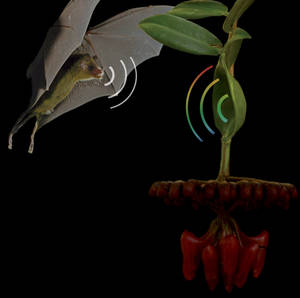A species of tropical vine attracts its bat pollinators using acoustic signals, rather than bright colours or smells, according to a study published in the journal Science this week.
Over 1000 plant species are pollinated by bats. However, the majority of bat species are virtually blind and must locate nectar sources using echolocation, in which they send out high pitched sounds and use the echoes to build a mental map of their environment.
The plant featured in the study, Marcgravia evenia is a bat-pollinated vine. It has round, dish-shaped leaves associated with its flowers, which differ from its ordinary foliage leaves in shape and orientation. A group of European researchers suspected that these dish-shaped leaves were an evolutionary adaptation which helped to attract bats by strongly reflecting the signals they send out. They examined the echoes that were produced when sound waves were bounced off samples of these leaves, and detected a strong, distinctive acoustic signature.
 |
| Photo montage of an inflorescence of Marcgravia evenia and an approaching Cuban nectarfeeding bat Monophyllus remani. Note the dish-shaped leaf above the inflorescence that is reflecting the bat's echolocation call. Image courtesy of Ralph Simon / Science |
But do these signals alter bat foraging behaviour? To find out, they trained bats to find a nectar feeder hidden among foliage in a darkened room, then moved the feeder and recorded the time it took the bats to find it. They first tested the feeder alone, and then tested it paired with either a foliage leaf or a dish-shaped leaf. The presence of a foliage leaf made no significant difference to the time the bats spent searching, however, when a dish-shaped leaf was used the bats found the feeder twice as fast.
"Our finding is the first of its kind," said Dr Marc Holderied from the University of Bristol. "This plant is special because it is the echo-acoustic equivalent of the bright floral colours that we are so familiar with. Its function is to attract and draw in a pollinator, but it doesn't do it with colour, it does it with a specific acoustic signature, so in a sense we have found an acoustic 'beacon' and this is the first time that has been found in science."
Research which helps improve our knowledge of the relationships between plants and their pollinators is important, as it gives scientists a better understanding of how ecosystems function.
It is likely that there may be other instances of acoustic signalling in the plant kingdom that are yet to be discovered. "We are just starting to understand this whole field of floral acoustic signalling," said Dr Holderied, "and I think we might find some amazing adaptations. The more plants we look at the more we will find."










Comments
Add a comment